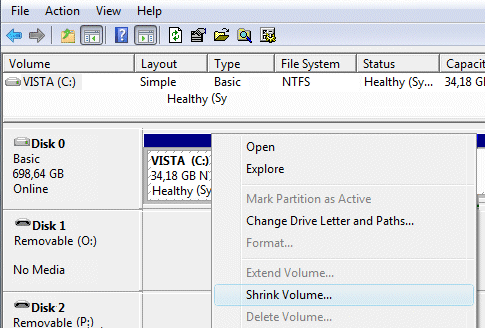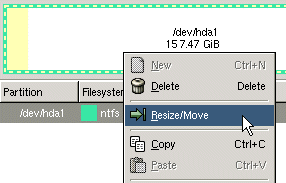
In most cases, the hard disk of a new computer is partitioned into one single partition. When an additional partition is needed (for example to separate the personal files and the operating system, to set up a multiboot system and/or to make an image of the Windows system), the system partition has to be resized first (by keeping the already available files as they are and not having to worry loosing the installed Windows, programs and personal data). The space which comes available, can be used for new partitions.
Resizing the existing Windows partition without loosing data saves a lot of time compared to a complete reinstallation of Windows, but it isn't without a risk... This page describes how to resize the Windows partitions safely (keeping the existing files). For more information about the preferred partition table settings, visit the page about partitioning of the hard disk.
How much smaller is possible?
The maximum space to become available after a resize is determined by the last
occupied sector on the partition. However, the total free space available on the
partition is cut into bits because the files are spread over the whole partition
(in stead of defragmented at the beginning of the partition) which gives 'holes'
between the occupied sectors. Resizing the partition is simple when only the
last not occupied sectors can be 'cut off'. When this operation doesn't result
in a small enough partition, the files at the end of the partition can still be
moved with specialized partitioning software to the not occupied sector at the
beginning of the partition. In theory, the smallest partition possible is the
total combined size of the files on the partition. For this purpose, the all
files have to be moved to the beginning of the partition which can't be done
within Windows. It will be clear that this is not without a risk!
|
|
There are only a few tools suitable to resize a partition safely without loosing data. Within Windows Vista, the tool Windows Disk Management can be tried as a first step. This tool is quickly available and relatively safe to use, but the resizing is limited to the occupied sector of the last system file. When the result does not satisfy, then a more advanced tool has to be used.
Although there are multiple free partitioning tools available for the resizing of a partition (like GParted and EASEUS), commercial partitioning tools give the best result. Unfortunately, not all (commercial) partitioning tools are ready to shrink a partition with the newest NTFS file system used by Windows Vista (event the very popular tool Partition Magic is not able to handle the Windows Vista partitions safely!).
Windows Disk Management (Windows Vista only)
The Windows partition can be resized quick, easy and relatively safe with
the Windows Vista partitioning tool Windows Disk Management (Control
Panel, sub Administrative Tools,
sub Computer Management or
right clicking Computer (in the Windows Explorer),
option Manage).
Right click the partition to be resized and select Shrink Volume. Windows
Disk Management will show a Window with the maximum result possible for the
specific partition. Set the desired new partition size and press Shrink.

Because Windows Disk Management is started within Windows, it is not able to move (system) files which are in use by a running process. Among these files are the pagefile (for the virtual memory), the hibernation file (for the hibernation feature), the files in the folder System Volume Information (for system restore) and the temporary internet files. For this reason, the result is disappointing in most cases. Despite these issues, Windows Disk Management can be used quite safely (and freely!). It doesn't hurt to try this tool first before using more extensive partitioning tools!
MOVING OR DELETING OCCUPIED (SYSTEM) FILESThe (system) files which are stored on the last occupied sectors of the partition are deleted or moved safely by (temporarily) disabling the specific process which holds the file (visit the page disk cleanup (Vista) / disk cleanup (XP) for more information about disabling the mentioned features). The defragmentation tool VOPT (download: www.vopt.com) can be used to tell which files are stored on the last occupied sector. These are the files to move or delete to be able to shrink the partition. |
The free partitioning tool GParted
When the Windows Disk Management tool doesn't result into the preferred resized
partition, then it is time to apply more advanced partitioning tools. In case of
free software, the tool GParted is most used at this moment. GParted is
integrated into multiple bootable Linux distributions, like the GParted Live CD (download:
http://gparted.sourceforge.net/livecd.php).
After starting the computer from the CD, the Windows operating system is not
active anymore. Because the files which were previously occupied by a process
are now free, they can be moved by the partitioning tool.
GParted has some shortcomings like the badly supported SATA hard disks and RAID configurations. Especially in case of a computer with a RAID configuration, some reserve is needed, because GParted doesn't give any warning! In my case, the Windows Vista installation on a RAID 1 configuration was no longer accessible after resizing it with GParted (afterwards, I noticed that GParted doesn't show the two mirrored hard disks as one, but both as individual hard disks...). So, if the computer uses a RAID configuration, my advise would be not to use GParted to partition/resize the Windows partition.
ATTENTION: When a different Linux distribution (like Parted Magic (http://partedmagic.com) which includes the latest available version of GParted faster compared to the GParted Live CD) is used, make sure this distribution contains the latest version of GParted. This is important because the latest version is able to handle the renewed NTFS file system used by Windows Vista.
ATTENTION: Don't burn the downloaded ISO file directly on a CD-R (a frequently made error by beginners)! An ISO file contains an image of the original CD which can be burned on CD with burning software (like Nero). For this purpose, the free tool Active@ ISO Burner (download: www.ntfs.com/iso-burning.htm) can be used as well.
Put the GParted Live CD CD into the DVD player and reboot the computer from this CD. To start GParted, press ENTER on each question asked. Right click the partition to be resized, select Resize/Move and enter the desired new size into the opened window at New Size. The button Apply will apply the new settings, this can take a few minutes or even hours.

ERROR MESSAGE AFTER RESIZING THE WINDOWS VISTA PARTITIONThe Windows Vista boot process will probably be messed up when the Vista partition is resized with an error message as result. In most cases, this problem is solved easily by starting the repairing procedure from the Windows Vista DVD, so keep this DVD within reach! Accept (after booting from the DVD) the country and language settings, select Repairing your computer, confirm the repairing process with the button Repair and reboot your computer and remove the DVD. After rebooting the computer, the boot menu of the Windows Boot Manager is shown with two option, where the second option is the repaired Windows installation. Select this option and Windows will start Check disk. After the volume has been checked and errors have been fixed, Windows should function normally. The last step is to remove the no longer functioning entry from the boot menu and to change the name of the added repaired entry. This can be done by the tool EasyBCD (download: www.neosmart.net/dl.php?id=1) or manually with the command BCDEDIT (at the bottom of the page). |
RESIZING THE WINDOWS PARTITION WITH EASEUSAs an alternative to resize a Windows partition, EASEUS Partition Manager Home Edition (download: www.partition-tool.com/personal.htm) can be used as well. The free version can be used for the 32-bits version of both Windows XP and Windows Vista and is able (in contrary to GParted) to handle most SATA- and RAID-configurations. EASEUS can be started within Windows to resize the Windows-partition (after reboot, the changes will be made to the partition table). |
Commercial partitioning tools
Windows Disk Management is not always able to shrink the Windows partition and GParted
doesn't always support the SATA hard disks and RAID configurations. When a
smaller partition is still preferred, a commercial tool has to be used. Although
most partitioning tools are able to resize a Windows XP partition, there are
only a few which I trust shrinking the renewed NTFS file system of Windows
Vista.
There is still no new version of the popular Partition Magic tool which is suitable for the Windows Vista partition as well (and I don't think it will ever come, because Symantec has become the reputation of buying out the owners of good software followed by a liquidation of the software...). Paragon Partition Manager 9.0 (www.partition-manager.com; note the version number) seems to be a trustworthy tool to replace Partition Magic. By almost all Windows Vista installations, this tool is able to shrink the Windows partition safely. By using this software, you can save yourself a lot of time for a relatively small amount of money!
WARNING: Resizing the Windows partition is not without a risk! I found out myself after testing the tool GParted... My Windows Vista installation ended up in unsolvable boot problems, probably because of the bad support for RAID configurations. It was necessary to restore an image of the Windows partition to repair the damage! Make sure you store the essential personal files on a safe location first (and create an image of the system if possible) before starting the resizing of the Windows partition!
© 2001-2022 - Menno Schoone - SchoonePC - Rotterdam - The Netherlands